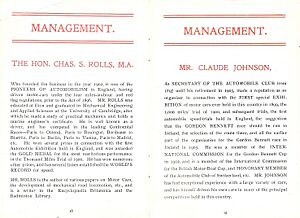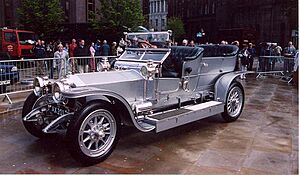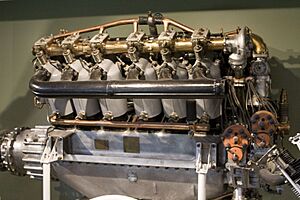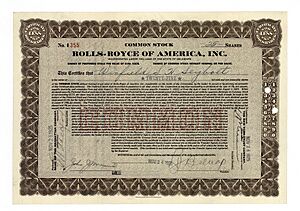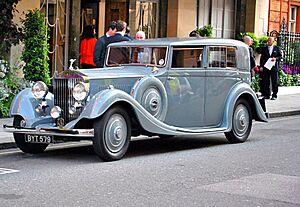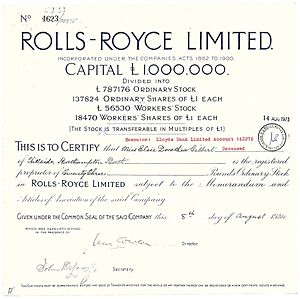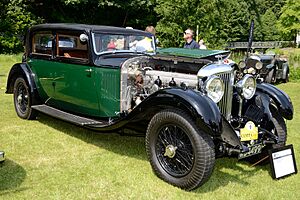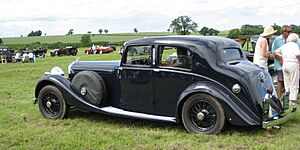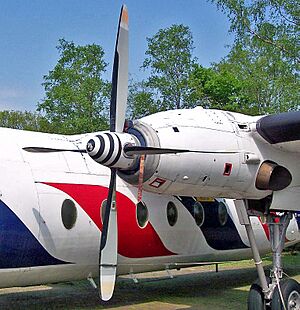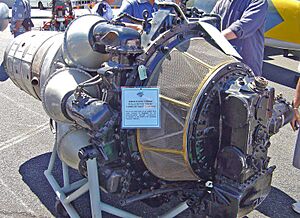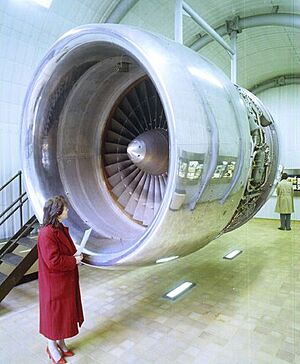Rolls-Royce Limited facts for kids
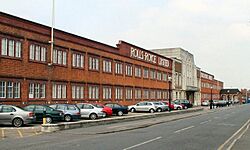 |
|
|
Formerly
|
|
|---|---|
|
|
| Industry | Automotive Manufacturing |
| Fate |
|
| Predecessor | Partnership of Rolls and Royce (1904–1906) |
| Successors |
|
| Founded |
|
| Founders | |
| Defunct | April 1987 |
| Headquarters |
,
United Kingdom
|
|
Key people
|
|
| Products |
|
| Subsidiaries |
|
Rolls-Royce Limited was a famous British company that made luxury cars and, later, airplane engines. It started in 1904 in Manchester thanks to a partnership between Charles Rolls and Henry Royce.
Henry Royce was already known for his excellent engineering. Together, they quickly became famous for building "the best car in the world." The company officially became "Rolls-Royce Limited" in 1906. A new factory opened in Derby in 1908.
During the First World War, the company began making engines for airplanes. They started working on jet engines in 1940, and these engines were ready for use by 1944. Rolls-Royce has since built a strong reputation for making engines for both military and commercial aircraft.
In the late 1960s, Rolls-Royce faced big problems. They had trouble developing their new RB211 jet engine, which cost a lot more than expected. In 1971, the company had to close down. The British government stepped in and bought the important parts of the business, creating a new company called "Rolls-Royce (1971) Limited." This new company continued the main business.
The car part of the business was sold to Vickers in 1980. In 1977, the company dropped the "1971" from its name and became "Rolls-Royce Limited" again. The business stayed owned by the government until 1987. Then, it was renamed "Rolls-Royce plc" and sold to the public. Today, Rolls-Royce plc still runs the main business, though it's part of a larger company called Rolls-Royce Holdings plc.
In 1987, a survey showed that only Coca-Cola was a more recognized brand than Rolls-Royce around the world.
Contents
Rolls-Royce Cars
Henry Royce began an electrical and mechanical business in 1884. He built his first car, a two-cylinder Royce 10, in his Manchester factory in 1904. Henry Royce met Charles Rolls on May 4, 1904, at the Midland Hotel, Manchester. Rolls owned an early car dealership in Fulham.
Rolls was very impressed with the Royce 10, even though he preferred cars with more cylinders. On December 23, 1904, they agreed that Rolls would sell all the cars Royce could make. There would be four different models:
- a 10 hp, two-cylinder car
- a 15 hp, three-cylinder car
- a 20 hp, four-cylinder car
- a 30 hp, six-cylinder car
All these cars would be called Rolls-Royces and sold only by Rolls. The very first Rolls-Royce car, the Rolls-Royce 10 hp, was shown at the Paris Salon in December 1904.
Starting the Company
Rolls-Royce Limited was officially created on March 15, 1906. They needed a new place to build their cars. After looking at several cities, they chose Derby because the city offered cheap electricity. The new factory was mostly designed by Royce himself. Car production started there in early 1908, and the factory officially opened on July 9, 1908.
To get more money for the new company, they offered £100,000 worth of shares to the public in December 1906. In 1907, Rolls-Royce bought out C.S. Rolls & Co., the dealership.
The Silver Ghost Car
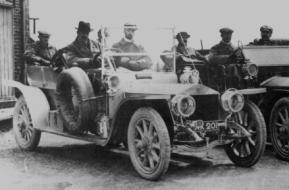
In 1906, Royce worked on a better six-cylinder car, more powerful than the Rolls-Royce 30 hp. This car was first called the 40/50 hp and was Rolls-Royce's first completely new model. In March 1908, Claude Johnson, who managed the business, convinced Royce to focus only on this new model. All older models were then stopped.
Johnson had an early car painted silver and named it Silver Ghost. The public and press quickly started calling all 40/50 cars "Silver Ghost." This name stuck until the 40/50 Phantom was introduced in 1925. Over 6,000 Silver Ghost cars were built, making it very important for Rolls-Royce's early fame. Its strong frame was even used for the first British armored car during both world wars.
Rolls-Royce Eagle Aero-Engine
Rolls-Royce started making airplane engines in 1914 because the government asked them to. The first engine, the Rolls-Royce Eagle, began production in 1915. Two Eagle engines powered the first non-stop flight across the Atlantic Ocean by Alcock and Brown in their converted Vickers Vimy bomber.
Rolls-Royce in the USA
In 1921, Rolls-Royce opened a new factory in Springfield, Massachusetts, USA. This was to help meet the high demand for their cars. Over 1,700 "Springfield Ghosts" and 1,241 Phantoms were built there. This factory, called Rolls-Royce of America, Inc., operated for 10 years. The first car was finished on January 17, 1921. When the factory closed in 1931, a total of 2,944 cars had been made.
The Smaller Rolls-Royce Twenty
After the First World War, Rolls-Royce avoided merging with other British car makers. Sales of the large 40/50 Silver Ghost were falling. So, in 1922, Rolls-Royce introduced a smaller, more affordable car called the Twenty. This ended their policy of making only one car model since 1908.
Rolls-Royce Phantom Cars
The new 40/50 hp Phantom replaced the Silver Ghost in 1925. The Phantom III, launched in 1936, was the last big model before World War II. After the war, a very limited number of Phantoms were made for heads of state, starting in 1950 and continuing until the Phantom VI stopped production in the late 1980s.
Bentley Joins Rolls-Royce
In 1931, Rolls-Royce bought Bentley. Bentley was a small maker of sports and racing cars that faced financial trouble during the Great Depression. Rolls-Royce stopped making Bentley's new Bentley 8 Litre car, which was competing with their own Phantom. They kept only the Bentley name and its good reputation.
After two years, Rolls-Royce introduced a new, very refined medium-sized Bentley, the Bentley 3½ Litre. It was advertised as "the silent sports car." From 1933 until 2002, standard Bentley and Rolls-Royce cars were almost the same. Only the front grille and small details were different.
In 1933, the color of the Rolls-Royce badge on the radiator changed from red to black. This was because the red sometimes didn't match the car's paint color chosen by customers. It was not, as some believe, because Henry Royce died that year.
Moving to Crewe
The British government built a factory in Crewe in 1938 for Rolls-Royce. Here, they could build their Merlin and Griffon airplane engines. Car production moved to Crewe in 1946 to make more space for aero engines at the Derby factory. Rolls-Royce bought the Crewe factory from the government in 1973. Today, it is known as Bentley Crewe.
World War II Efforts
In 1940, Rolls-Royce signed a deal with the Packard Motor Car Company in Detroit, USA. Packard would build Merlin aero-engines for World War II in the USA.
During the war, Rolls-Royce mainly focused on aero engines. A version of the Merlin engine, called the Meteor, was developed for the Cromwell tank. The Meteor engine's design was finished in 1943. The same team then started work on an eight-cylinder car engine. This engine became the basis for the British Army's B range of petrol engines for military vehicles after the war.
Post-War Changes
Car Bodies
After the war, in 1946, Rolls-Royce and Bentley car production moved to Crewe. They started building complete cars there, using body parts made by the Pressed Steel Company. Before this, they only built the car frames, and special coach-builders added the bodies. In 1939, Rolls-Royce bought Park Ward Limited, one of these coachbuilders.
In 1959, Rolls-Royce bought another coachbuilder, H J Mulliner. These two businesses were combined to form H J Mulliner Park Ward.
Diesel Engines
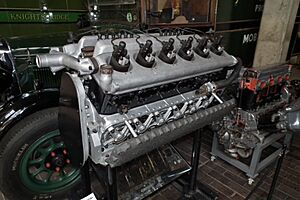
After the war, luxury cars were not as popular. Rolls-Royce began designing diesel engines in 1948 and started producing them in 1951. By 1955, they made diesel engines for cars, trains, industrial machines, earth-moving equipment, and boats.
In 1956, they bought Sentinel (Shrewsbury) Limited, which made machine tools and industrial trains. Rolls-Royce took over Sentinel's Shrewsbury factory for diesel engine production.
By 1973, their diesel engines included:
- C range: 4, 6, and 8 cylinder engines for generators, compressors, construction, and marine use.
- Eagle: A modified 6-cylinder C range engine for heavy vehicles.
- D range: V engines for generators, marine, and railway uses.
Aero-Engines
In 1907, Charles Rolls, who loved flying, tried to convince Royce to design an aero engine. Royce and the other directors said no. When World War I started in August 1914, Rolls-Royce was surprised. As a luxury car maker, they were in a difficult spot. However, they soon agreed to make fifty V8 engines under a license from Renault.
The Royal Aircraft Factory also asked Rolls-Royce to design a new 200 hp engine. Rolls-Royce agreed, and in 1915, they developed their first aero engine, the twelve-cylinder Eagle. This was followed by smaller engines like the Hawk and Falcon, and then the larger Condor near the end of the war.
During World War I, Rolls-Royce struggled to build enough aero engines. They refused to let other companies make their engines, fearing it would lower the quality. Instead, they expanded their Derby factory to increase their own production. By the late 1920s, aero engines became the biggest part of Rolls-Royce's business.
Henry Royce's last design was the Merlin aero engine, which first flew in 1935, even though he had died in 1933. This engine was developed from the R engine, which powered a record-breaking Supermarine S.6B seaplane to almost 400 mi/h in 1931. The Merlin was a very powerful V12 engine. It was used in many World War II aircraft, including the British Hawker Hurricane, Supermarine Spitfire, de Havilland Mosquito, and Avro Lancaster. It also improved the American North American P-51 Mustang, making it one of the best fighters of its time. Over 160,000 Merlin engines were produced.
In December 1942, Rolls-Royce agreed to take over top-secret work on developing the jet engine from the Rover Car Company. After World War II, Rolls-Royce made big advancements in gas turbine engine design. The Dart and Tyne turboprop engines were very important. They helped airlines cut travel times for shorter flights while jet airliners were used for longer ones. Many of these turboprop engines are still in use today.
Other jet engines from this time included the RB163 Spey. This engine powers planes like the Hawker Siddeley Trident and BAC One-Eleven.
In 1966, Rolls-Royce bought Bristol Siddeley, another engine manufacturer. This company had a strong base in military engines, including the Olympus and Pegasus. They were also working on the Olympus 593 Mk610 for the Concorde plane.
The former Rolls-Royce factory at Leavesden Aerodrome, Watford, was used for making helicopter engines. It closed in 1993. This site is now known as the Leavesden Film Studios, where famous movies like Harry Potter were made.
RB211 Engine and Government Takeover
By the 1980s, each new generation of aero engines cost about 10 times more to develop than the one before it. Rolls-Royce employed 80,000 people at this time. It was known that the company needed government help for its RB211 engine program. This was due to tough competition with companies like Pratt & Whitney and General Electric.
In early 1971, financial problems, mostly from developing the new RB211 turbofan engine for Lockheed Aircraft Corporation's new L-1011 TriStar plane, led Rolls-Royce to run out of money. On February 4, 1971, the company had to close down.
The British government decided to buy the important parts of the business. This included the aero-engine, marine, and industrial gas turbine divisions. These were important for national defense and international projects. A new company, Rolls-Royce (1971) Limited, was created in May to buy these parts. The original company, Rolls-Royce Limited, was officially closed on October 4, 1971.
Lockheed, the American aircraft maker, warned that switching to different engines would delay their plane production by six months. This could even make Lockheed go bankrupt. The receiver (the person managing the closed company) worked with Lockheed to avoid further problems.
The first asset sold was British Aircraft Corporation, bought by Vickers and GEC. The receiver then sold the car division, Rolls-Royce Motors, in 1973.
New Leadership
The new company, Rolls-Royce (1971) Limited, had a new board of directors. These included important people from other major companies and government advisors.
Lockheed and Rolls-Royce Fly
The new Lockheed L-1011 plane, with its three RB211 engines, flew from the USA to Paris on June 1, 1971. It received its airworthiness certificate on April 14, 1972. The first plane was delivered to Eastern Air Lines on April 5, 1972.
Rolls-Royce Motors (1973)
Rolls-Royce Motors Limited was created on April 25, 1971, shortly after Rolls-Royce went into receivership. It started making cars, diesel and petrol engines, and other items previously made by Rolls-Royce's car and diesel divisions.
In June 1971, it took over all the business and assets of the car and diesel divisions. Rolls-Royce Motors was allowed to use the Rolls-Royce brand names in very specific ways.
By the end of 1972, Rolls-Royce Motors had 5,855 employees in its car division and 2,311 in its diesel division. In May 1973, the business was sold to Rolls-Royce Motors Holdings Limited, preparing it to be sold to the public.
Car Division
The Car Division made cars and special car bodies. It also did precision engineering work and produced piston engines for light aircraft. The car division's main offices were in Crewe. Special coachbuilding continued in London. The Crewe factory was bought from the government at this time.
Diesel Division
The Diesel Division made several types of diesel engines in Shrewsbury. It also made parts for aero turbine engines.
- Rolls-Royce Motors products included
- Motor cars
- Diesel engines
- Aero turbine engine parts and aircraft piston engines
- Other engines and products, like petrol engines and transmissions for vehicles.
Sale to Vickers
On August 6, 1980, Rolls-Royce Motors Holdings merged with Vickers Limited. Vickers later sold Rolls-Royce Motors to Volkswagen Group in 1998. However, the Rolls-Royce trademark was controlled by the aero-engine company. So, the car company was renamed Bentley Motors. BMW then started a new company called Rolls-Royce Motor Cars to make Rolls-Royce cars.
Perkins Engines
The Rolls-Royce diesel engine business was bought from Vickers in 1984 by Perkins Engines. Perkins further developed the Eagle Diesel engines.
Rolls-Royce Changes Name (1977)
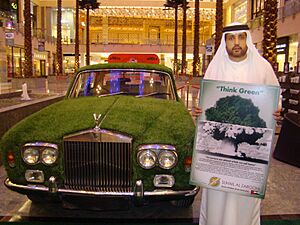
The name of Rolls-Royce (1971) Limited was changed to Rolls-Royce Limited on December 31, 1977. The original Rolls-Royce Limited, which was still being closed down, had been renamed Rolls-Royce Realisations Limited. It agreed in March 1977 for the (1971) company to use the name Rolls-Royce Limited.
The word "Limited" was changed to "plc" (meaning public limited company) in the summer of 1986. This allowed shares to be offered to the public and traded on stock markets.
Rolls-Royce Becomes Private Again (1987)
In April 1987, the government sold all its shares in Rolls-Royce plc. This sale, which was heavily advertised, was very successful.
Making civil aero engines is a very long-term business. It can take 4 to 6 years to develop an engine before it even starts being used. Military engines often take even longer. Production might then continue for another 50 years, including making spare parts long after new engines are no longer built.
Customers
According to the information given to the public for the 1987 share sale, Rolls-Royce was one of only three companies outside the USSR and China that could design, develop, and produce large gas turbine engines. At that time, their engines were used in planes by over 270 airlines. They were also used by 110 armed forces and 700 operators of private and corporate aircraft.
In addition, their turbines powered naval ships for 25 different countries. Over 175 industrial customers used Rolls-Royce gas turbines for generating power, pumping gas and oil, and other industrial uses. The most important customer was the United Kingdom's government. In the five years before 1987, about 70% of their production was sold outside the United Kingdom.
Competitors
Rolls-Royce's main competitors were GE and Pratt & Whitney (UTC). These companies were large industrial groups, and aero engines were only one part of their business. Other smaller manufacturers often worked together or with GE.
Business Groups and Products
In 1987, Rolls-Royce was organized into five main business groups:
- Civil Aero: Made engines for airlines.
- Military Aero: Made engines for military aircraft and helicopters.
- Industrial and Marine: Made gas turbine engines based on aero engine designs.
- Repair and Overhaul: Provided maintenance and repair services.
- Nuclear: Made steam-raising equipment for submarines.
Products Made
Cars
(Rolls-Royce only built the chassis, not the full car body, until the Silver Dawn model.)
- 1904–06 10 hp
- 1905–05 15 hp
- 1905–08 20 hp
- 1905–06 30 hp
- 1905–06 V-8
- 1906–25 40/50 Silver Ghost
- 1922–29 Twenty
- 1925–29 40/50 Phantom
- 1929–36 20/25
- 1929–35 Phantom II
- 1936–38 25/30
- 1936–39 Phantom III
- 1938–39 Wraith
- 1946–59 Silver Wraith
- 1949–55 Silver Dawn
- 1950–56 Phantom IV
- 1955–65 Silver Cloud
- 1959–68 Phantom V
- 1965–80 Silver Shadow (a car with a single body structure)
- 1968–92 Phantom VI
- 1971–2002 Rolls-Royce Corniche
- Bentley Models (from 1933) – chassis only
- 1933–37 Bentley 3½ L
- 1936–39 Bentley 4¼ L
- 1939–41 Bentley Mark V
Aircraft
- Rolls-Royce Thrust Measuring Rig
- Rolls-Royce Mustang Mk.X
Images for kids


